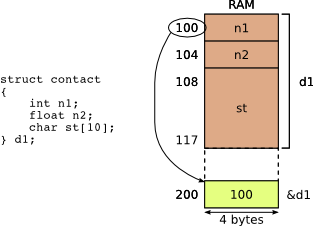| 5.2. The indirection | ||
|---|---|---|
 | Chapter 5. Pointers in C |  |
Let us suppose that the memory address are represented
internally by the processor using 32 bits (4 bytes). We can then store the
address of d1 (the number 100) in a different memory location
occupying 4 bytes because it is a memory address. The following figure
shows this situation with the memory addresses stored in position 200.

The memory address of any variable in C may be obtained
using the & operand followed by the a variable name. In the
previous figure, the expression &d1 returns the value
100.
The value returned by the & operator
depends on the position of its operand, and therefore is not under the
control of the programmer. The memory address stored as a regular data in
the address 200 is known generically as a “pointer” because its
value “points to” the location of d1. Another way
of saying the same is: address 200 contains a pointer to
d1.
If position 200 contains a pointer to the variable
d1, the fields of this data structure can be accessed through
an “indirection”. The data stored in position 200 is taken and
its value (the number 100) is now interpreted as a memory address. We access
to that direction and in there we may access to the fields of
d1. We just accessed to d1 indirectly, or through
an “indirection”.
The indirection can be applied multiple times in the same
access in what is known as “multiple indirection”. Following
with the previous example, we may now store the address of the pointer (that
is, the value 200) in another memory location, for example, position 300. In
this position we now have the address of the address of d1. Or
analogously, in position 300 we have a pointer to a pointer to
d1. As in the previous case, we may access the fields in
d1 but this time using a double indirection. It is possible to
build multiple indirections with an arbitrary number of levels.